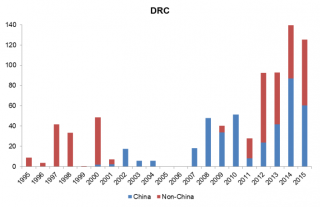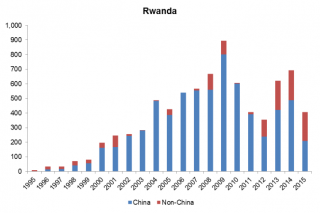Much depends on whether or not the industry has learned the lessons of the past 15 or so years, and on whether or not it makes the same mistakes again, given that the nature of the industry has changed in many ways.
Although there had long been both conventional and artisanal tantalum production in Africa, it was not until the late 1990s that artisanal mining in central Africa became a major factor, with the rise in output fuelled by rapid growth in demand for computers, mobile telephones and other consumer electronics that use components containing tantalum.
Prior to that, global supply had come mostly from conventional mines in Australia, Brazil and elsewhere, and from slags generated during tin smelting. Slags were once the main source of tantalum, and are still of significance (representing about 11% of supply in 2015) but their importance fell after the tin price crash of the mid-1980s that led to the demise of tin mining in Thailand, where tantalum-rich ores were produced. Even as recently as the mid-2000s, conventional mining still held the number one spot, with the Wodgina and Greenbushes mines in Australia alone making up some 60% of total supply.
The first real market upset came in the early-2000s when rapidly growing demand for tantalum, coupled with a wholly unfounded belief that a shortage was imminent, saw prices spike to a mine-bending US$772,000 per tonne of Ta2O5, about six times today’s price. A number of major buyers locked-in long-term supply contracts at the prevailing price. Demand then turned down, there was no shortage and prices tumbled, leaving buyers facing huge financial write-downs and large tantalum inventories that remained in the system for years. Those inventories were made even larger by the US government selling its strategic stockpile of tantalum, albeit over a period of several years.
While that was happening, artisanal supply from Central Africa was growing, as shown in the accompanying charts. The very nature of artisanal mining means tantalum produced in this way is far lower-cost than material produced from conventional mining. There was a snag, however. Much of the material from central Africa was coming from the eastern DRC, smuggled out through Rwanda and other countries, and used to fund the various warring factions. The name ‘conflict tantalum’ appeared. Given the uncertainty over where tantalum was being mined, most processors outside China simply stopped buying ore from anywhere in the region. That, of course, does not mean they stopped buying downstream materials, such as K-salt (potassium fluorotantalate) or tantalum metal, which were then much harder to trace back to the original mine source.

Recorded imports of tantalum ores and concentrates from the DRC (above) and Rwanda (below): Estimated tonnes Ta2O5
As time went on, the availability of cheap Central African material made it harder and harder for conventional miners to win the contract prices they needed to continue producing profitably. Although individually negotiated, contracts were based on market prices. In late 2008, the Australian producer Talison (formerly Sons of Gwalia and now known as GAM) tried to impose a large increase in its contract prices, probably given its current contracts were uneconomic for the company. With the global economic collapse in full swing, very low market prices and substantial inventory already in the system, it failed and stopped producing, which came as another shock for the market.
Prices did go up again, prompting the by-then GAM to restart production in 2011. That did not last. Prices fell again, resulting in another closure. While all this was going on, the Tanco mine in Canada closed, Marropino in Mozambique failed, the much-vaunted mega-projects in Egypt and Saudi Arabia flatlined and most junior mining projects struggled to raise finance.

What has been happening more recently?
Of great importance have been the moves by both governmental organisations and the tantalum industry to clean up the supply chain for Central Africa tantalum.
In the US, the Dodd-Frank legislation requires SEC-listed companies to report on their sourcing of materials that could be from countries linked identified as sources of conflict minerals. Contrary to popular belief, Dodd-Frank does not prohibit the purchase of such materials. Companies do, however, have to report whether they are not buying such material, are buying such material or are simply not sure.
The last two are a public relations nightmare. It has forced companies to put their supply chains under the microscope, all the way back to the mine. That is not an easy task but ‘bagging and tagging’ systems have been introduced to help. Industry itself has taken more control over the supply chain, in some cases introducing ‘closed pipe’ initiatives. This has all made a difference, although work remains to be done and smuggling from the DRC via Rwanda continues, albeit mostly for reasons of simple tax evasion.
The net result is that processors in countries other than China are now more willing to purchase material from central Africa than they were a few years ago, as the charts show. It is worth noting most major Chinese processors have been very careful about their sourcing for some years.
There are also signs of resurgence in conventional mining. The large Mibra mine in Brazil is now essentially captive to the processor GAM and its near-term future looks secure, at least until the contract expires and has to be renegotiated. Pitinga, the other large mine in Brazil is expanding, and that expansion will likely continue for several years.
In Australia, reopening of the legacy mines does not seem to be on the cards, but there are several projects in the pipeline that could increase tantalum production significantly, along with good potential for increased tantalum supply coming as a by-product of lithium production.
What does the future hold?
It is perhaps a good idea to look at past events (and hope lessons have been learned). Demand for tantalum is not going to suddenly surge; there are no major new applications coming. Overall demand will grow gently, at best.
The artisanal mining sector in central Africa has been legitimised, not entirely but sufficiently. Increased demand could be met from those sources, quickly and now generally guilt-free. Supply from Australia offers a wholly legitimate option but it will to some extent depend upon the lithium market.
Much will hinge on whether or not the tantalum space has learned from the mistakes of the past and act more rationally. Underlying tantalum prices should rise from current levels, but not dramatically or erratically. A fall in market prices would render the conventional mining sector uneconomic and would make even artisanal mining somewhat unattractive. Another spike in market prices would surely follow. This has happened before and only time will tell if it happens again.
*Patrick Stratton is director and manager of steel alloys research for metals and minerals research firm Roskill, which has just released its new tantalum market report with forecasts out to 2020

























